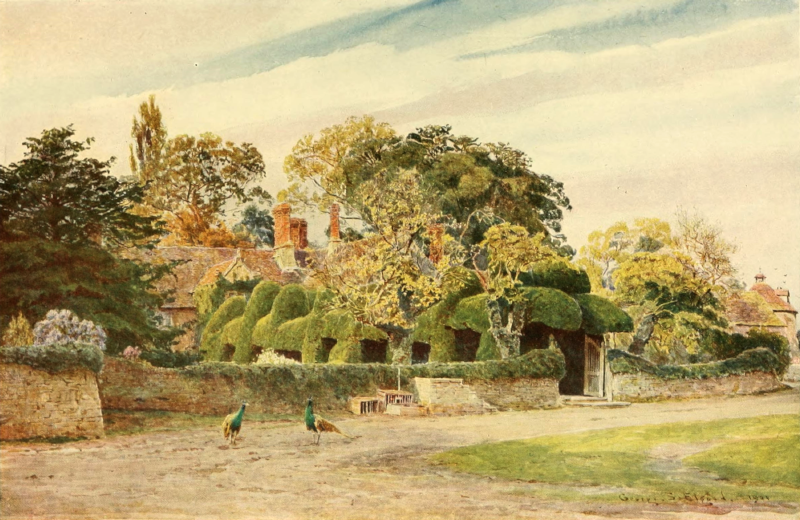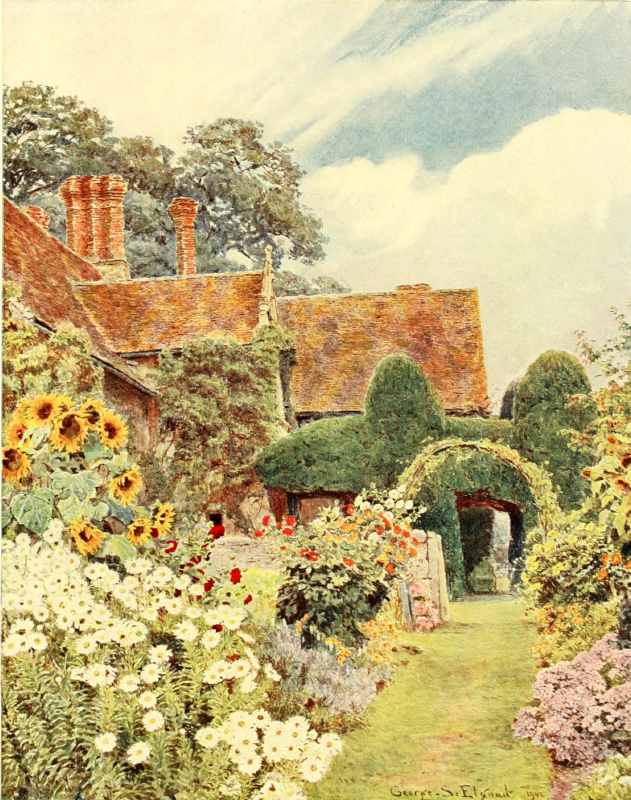| Web
and Book design,
Copyright, Kellscraft Studio 1999-2021 (Return to Web Text-ures) |
 (HOME)
|
|
CLEEVE
PRIOR
Near
a quiet village in Warwickshire, and in close relation to its accompanying farm
buildings, is this charming old manor house. It is not upon a main road, but
stands back in its own quiet place on rising ground above the Avon. Everything
about it is interesting and quite unspoilt. The wooden hand-gate, with its
acorn-topped posts, that stands upon two semi-circular steps may not have been
of the pattern of the original gate — it has an eighteenth-century look — but
it is just right now. It leads into a half dark, half light, double arcade of
splendid old clipped yews. Looking from the gate they seem to be tall walls of
yew to right and left, showing the projecting porch of the house at the end; but,
passing along, there are seen to be openings between every two trees, each of
which gives a charming picture of the lawns and simple flower beds to right and
left. The path is paved with stone flags; the garden is bounded with a low wall
of the local oolite limestone that rock-plants love. A few thin-topped old
fruit-trees, their stems clothed with ivy, are another link between the past
and present, and the somewhat pathetic evidence of their having long passed
their prime and being on the downward path, is in striking contrast with the
robust vigour of the ancient yews, already some centuries old, and looking as
if they must endure for ever. Eight
yews stand on either side — sixteen in all. They are known as the twelve
Apostles and the four Evangelists. The names may have belonged to them from the
time of their planting, for the whole place belonged in old days to Evesham
Abbey, and is pervaded with monastic memory and tradition. This may also
account for the excellence of the buildings, for the old monks were grand
constructors, and their structures were not only solid but always beautiful. One
of the older of these at Cleeve Prior is a large circular dovecote of stone
masonry with tiled roof and small tiled cupola. Such buildings were not
unfrequent in the old days, and many of them remain. Sometimes they are round
in plan, sometimes four-, sometimes eight-sided. Occasionally there is a
central post inside, set on pivots to revolve easily, with lateral arms
carrying a ladder that reaches nearly to the walls, so that any one of the many
pigeon-holes can be reached. To
the left of the Apostles' Garden, as you stand facing the house, a little gate
leads into the vegetable garden. It has narrow grass paths bordered with
old-fashioned flowers. A further gate leads into the orchard. Behind the house
is the home close with some fine trees; on two other sides are the farm
buildings, yard and rickyard. How
grandly the flowers grow in these old manor and farm gardens! How finely the
great masses of bloom compose, and how beautifully they harmonise with the grey
of the limestone wall and the wonderful colour of the old tiled roof; both of
them weather and lichen-stained; each tile a picture in itself of grey and
orange and tenderest pink. The
yews have got over their paler green colour of the early summer when the young
shoots are put forth, and have settled into the deep green dress that they will
wear till next May. For the time is September; wheat harvesting is going on and
the autumn flowers are in full vigour. There are Dahlias, the great annual
Sunflowers and the tall autumn Daisy; Lavender and Michaelmas Daisies, with
sweet herbs for the kitchen, just as it should be in such a garden.  THE TWELVE APOSTLES, CLEEVE PRIOR From the picture in the possession of Sir Frederick WiganSome
of these old pot-herbs are beautiful things deserving a place in any flower
garden. Sage — for instance — a half shrubby plant with handsome grey leaf and
whorled spikes of purple flowers; a good plant both for winter and summer, for
the leaves are persistent and the plant well clothed throughout the year.
Hyssop is another such handsome thing, of the same family,
with a quantity of purple bloom in the autumn, when it is a great favourite
with the butterflies and bumble bees. This is one of the plants that was used
as an edging plant in gardens in Tudor days, as we read in Parkinson's
"Paradisus," where Lavender-cotton,
Marjoram, Savoury and Thyme are also named as among the plants used for the
same purpose. Rue, with its neat bluish-green foliage, is also a capital plant
for the garden where this colour of leafage is desired. Fennel, with its
finely-divided leaves and handsome yellow flower, is a good border plant,
though rarely so used, and blooms in the late autumn. Lavender and Rosemary are
both so familiar as flower-garden plants that we forget that they can also be
used as neat edgings, if from the time they are young plants they are kept
clipped. Borage has a handsome blue flower, as good as its relation the larger Anchusa.
Tansy, best known in gardens by the handsome Achillea Eupatorium, was an old
inmate of the herb garden. Sweet Cicely (Myrrhis odorata) has beautiful
foliage, pale green and fern-like, with a good umbel of white bloom, and is a
most desirable plant to group with and among early blooming flowers. And we all
know what a good garden flower is the common Pot Marigold. The
old farm buildings at Cleeve Prior are scarcely less beautiful than the
manor-house itself, and are remarkable for the timber erections, open at the
sides but with tiled roofs, that give sheltered access, by outside stairways,
to the lofts. Throughout
England the older farmhouses and buildings are full of interest, not only to
architects, but to many who are in sympathy with good and simple construction,
and have taken the pleasant trouble to learn enough about it to understand how
and why the buildings were reared. And in these restless days of hurry and
strain and close competition in trades, and bad, cheap work, it is good to pass
a quiet hour in wandering about among structures set up four or even five
centuries ago by these grand building monks. The present writer had just such a
pleasure not long ago in the South of England, where a large group of monastic
farm buildings stands within sound of the wash of the sea. They are on sloping
ground, inclosing three sides of a square; a wall, backed with trees, forming
the fourth side.
On the upper level is a great barn; a much greater, the tithe barn, being
opposite it on the lower. Buildings containing stables, cattle-sheds and
piggeries connect the two. Between these and the wall opposite is a spacious
yard; across the middle is a raised causeway dividing the yard into two levels.
 CLEEVE PRIOR: SUNFLOWERS From the picture in the possession of Mr. James Crofts Powell The
barns are of grand masonry. Some of the stones, next above the plinth — a
feature that adds so much to the dignity of the building, and by Its additional
width, to its solidity-measure as much as four feet six inches m length by
twenty inches in height. In every fifth course is a row of triangular holes for
ventilation, such as every brick or stone-built barn must have. They are
cleverly arranged as to the detail of the manner of their building, and though
only intended for use have a distinctly ornamental value. Where the walls rise
at the gable ends they are corbelled out at the eaves and carried up some two
feet above the line of the rafters, finishing in a wrought stone capping, thus
stopping the thatch. For the buildings are, and always have been, thatched with
straw, the ground around being good corn-land, a rich calcareous loam. There
is a delightful sense of restfulness about these fine solid buildings, built
for the plainest needs of the community of the material nearest to hand, in the
simply right and therefore most beautiful way. With no intentional ornament,
they have the beauty of sound, strong structure and unconsciously right proportion.
There is also a satisfaction m the plain evidence of delight in good
craftsmanship, and in the unsparing use of both labour and material. |